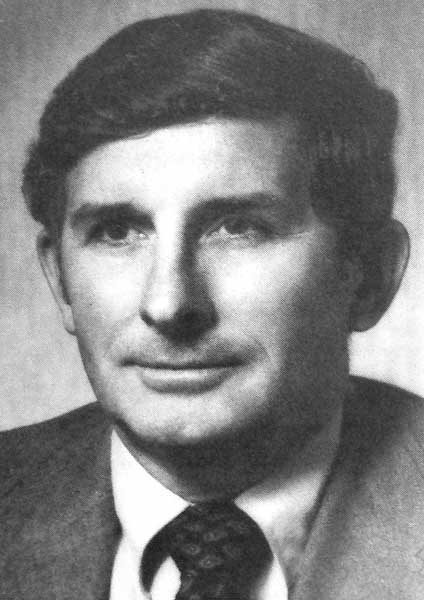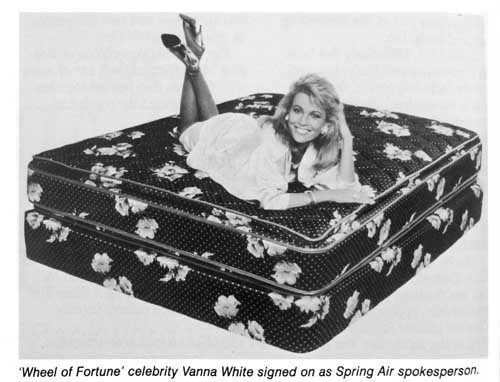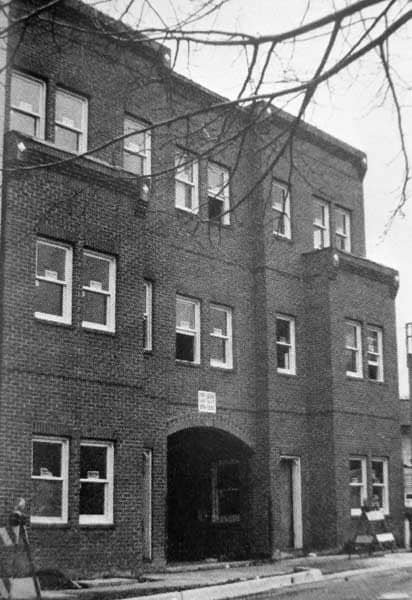The International Sleep Products Association’s first 100 years—Part I (main feature) of the third installment
Flammability regulations, computers, waterbeds and more arrive
BY JULIE A. PALM
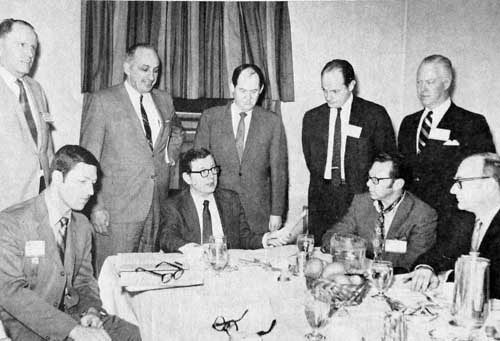
When the federal government began moving toward a cigarette flammability standard for bedding, the National Association of Bedding Manufacturers formed the Flammability Standards Committee to monitor developments.
When organizers of the mattress industry’s annual convention were coming up with a theme for the 1966 event, they settled on “The Challenge of Change.” It was not only an apt concept for that year, it was prophetic.
The period from 1966 to 1990 was a time of significant transformation for the industry, and, in many important ways ushered in the modern era that we know today. It was during these years that the industry first grappled with the “f-word”—flammability—and began to address in earnest the intractable problem of how to properly dispose of used bedding.
Meanwhile, both licensing groups and factory directs emerged as more powerful players. Company ownership structures began to shift, as the leveraged buyouts and equity-firm takeovers that swept through the U.S. corporate world in the 1980s made their way into bedding, too. The Simmons Co., a family-held business and top manufacturer for much of the era, changed hands several times, and, by the end of the 1980s, had become the industry’s first national ESOP, an employee-owned company. Internal conflicts and litigation consumed another “S” brand for nearly two decades in a struggle typically shorthanded as the “Sealy wars.”

Flammability became such a critical issue during this period that the magazine published by the National Association of Bedding Manufacturers ran no fewer than 17 cover stories about the topic.
This was a time when computers started appearing on office desks—and in the machinery on factory floors. Innerspring mattresses dominated sales during this period, but a near-disappearance of latex from the U.S. market for a time gave new, better-quality polyurethane foams the opportunity they needed to begin solidifying their place as a significant component in mattresses across price points.
Perhaps no part of the industry saw bigger changes than its own trade association, the National Association of Bedding Manufacturers, which, among other things, established its own statistics program to track industry sales, created entities devoted to both product safety and public relations, expanded the role for supplier members and changed its name to celebrate a more global mission.
Confronting a burning issue
From its start, NABM was dedicated to improving the quality and safety of bedding—getting unsanitary mattresses out of the marketplace was a fundamental reason for the association’s founding. Over the decades, NABM became adept at working with government agencies, not only on that effort, but on issues of misleading advertising and pricing strategies, as well. The world wars, with their price controls and materials shortages, took negotiations and cooperation between industry and government to a new level.
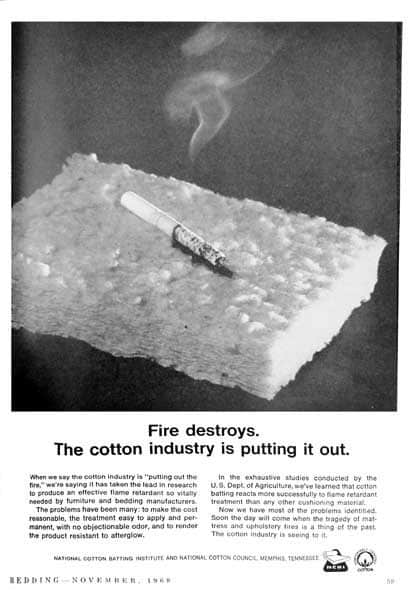
In the November 1968 issue of Bedding magazine, the National Cotton Batting Institute and the National Cotton Council published this ad promoting its efforts ‘to take the lead in research to produce an effective flame retardant so vitally needed by furniture and bedding manufacturers.’
In the 1970s, NABM would find itself drawing on all those lessons learned and relationships built when it faced federal regulations that would fundamentally alter the way mattresses were made and mandate unprecedented product testing and record keeping.
The first flicker of a problem appeared in 1967 when the Flammable Fabrics Act was amended to include home furnishings. Previous efforts to improve bedding quality had been largely industry-initiated. But flammability felt different, coming top-down from the federal government, and NABM went on high alert, closely monitoring what the amendment would mean for mattresses. When it became clear that the government was moving toward a cigarette flammability standard for bedding, NABM undertook its own research on cigarette test protocols, while suppliers set out to develop components that would resist cigarette ignitions.
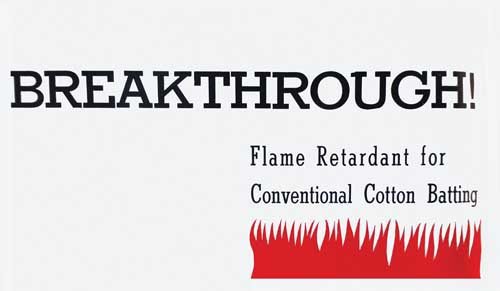
During the Flame Retardant Cotton Batting Workshop in 1969 in New Orleans, a representative from the U.S. Department of Agriculture told attendees, ‘Progress toward the development of satisfactory flame retardant treatment for conventional cotton batting has already been made.
Industry opinions about how to respond varied—some wanted to proactively engage with the government; others wanted to fight against the regulations. After extensive debate over the available options, the association decided the best course of action was to work with government officials to create solutions that addressed safety issues without destroying the mattress industry. It was not an easy task. As an industry magazine article reflecting on the process in October 1990 said, “There were countless meetings with government officials who had no understanding of mattress production and no history of developing flammability regulations—bedding was an early test case. And there were times … when both sides were ready to walk out in frustration and anger. But the years of research, negotiations and cooperation paid off.”
The federal mattress flammability standard (today known in the industry as the CFR Part 1632 cigarette flammability standard) went into effect in 1973. Through countless workshops, magazine articles and other educational efforts, NABM prepared mattress makers for the required testing and record-keeping procedures, but its work on flammability didn’t end there. NABM continued to press for amendments and, in 1984, a revised standard made a host of industry-supported changes, including the elimination of periodic sampling and testing from the production line.
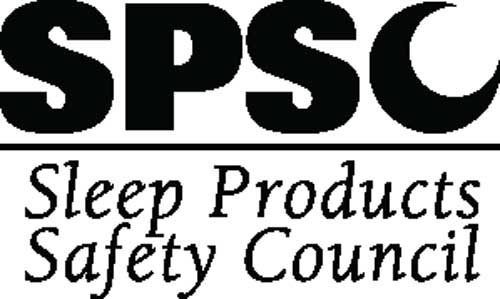
View this entire special section as it appears in the print magazine:
Read all four chapters in the 100-year history of ISPA :
Another now-regular part of NABM’s efforts: helping members navigate through a growing maze of federal agencies. At the height of flammability negotiations, Congress created the U.S. Consumer Product Safety Commission, giving it broad powers to regulate consumer products and write the rules related to consumer-safety laws. In 1973, the CPSC issued a list of 369 hazardous consumer products: Beds (including frames, headboards/footboards and box springs) were listed at No. 6. The bedding industry was not pleased, particularly because the accidents and injuries attributed to its “hazardous” product included not only fires started by children igniting bedding fabrics with matches or lighters but also “adults stubbing their toes on legs or casters,” the editors of Bedding wrote in November 1973.
The U.S. Occupational Safety & Health Administration, created in 1971, quickly began inspecting manufacturing facilities for general workplace safety violations. OSHA would cause more headaches for the industry in 1978 when it proposed a new standard regarding cotton dust hazards. It sought to reduce exposure by imposing engineering controls, medical surveillance and stringent record-keeping requirements not only on garneting but on mattress assembly operations that used cotton felt. NABM went to work once again: An amended regulation issued in 1985 exempted mattress assembly entirely and reduced requirements on garnetters.

In 1979—for the first time in the history of the National Association of Bedding Manufacturers—mattress industry suppliers were elected to the board of trustees. (Above) Douglas Moody of Western Bedding Supply Co.
Suppliers recognized
Suppliers showed their importance to the industry during the flammability fight. Indeed, they always had been a vital part of the trade association, but for decades, they weren’t allowed to be official voting members. That first began to shift in the mid-1940s, when they were given associate member status—but without representation on NABM’s board or its key decision-making committees. Even with their official power limited, suppliers fulfilled a larger role than even the associate label indicated. Working together under the Suppliers Council, they directly funded a variety of NABM projects, led membership drives for the association, helped market conventions and more. In 1975, NABM’s board and the Suppliers Council held a three-day joint meeting to discuss improving lines of communication between the two groups. The following year, NABM’s leadership voted to add supplier members to association committees and, most significantly, in 1979, suppliers were elected to three spots on the NABM board and given full voting rights. By 1989, the number of supplier slots on the board had grown to five.
“These actions marked the single most important step toward manufacturer/supplier unification within NABM to date,” wrote the editors of Bedding magazine in May 1979. “The effort to involve the supplier segment more actively in NABM decision-making processes has been progressing steadily for three years, following the recommendation in 1976 of the … Long Range Planning Committee that the two segments be integrated into one unified association with all members having equal status and equal vote.”
Membership statistics show the scope of supplier involvement by this time: According to a July 1981 Bedding article, NABM’s roster included 350 bedding manufacturing facilities and 270 supplier facilities.
Measuring an industry
A number of economic issues hampered the industry—both manufacturers and suppliers—during this period. Material shortages, the result of a confluence of events including increased competition from other nations for raw materials and government price controls domestically, put stress on everyone in the mid-1970s. Just as worrying were inflationary pressures, the oil crisis and the recession of the same period. Another recession struck in the early 1980s.
But, by and large, it was a period of growth. In fact, by the mid-1960s, the industry got a little giddy about the idea of becoming a billion-dollar sector. An article in Bedding in February 1967 trumpeted that the industry already had “joined the $1 billion club,” at least when it came to retail tallies—growth helped in part by sales of supersize bedding which, at the time, took average price points from $90 for a double bed to $400 for a king set. The U.S. Census Bureau, however, pegged the wholesale value of mattress and foundation shipments in 1967 to just over $708 million. But even government statisticians thought the $1 billion figure wasn’t far off, estimating that the “output of America’s bedding industry will top the $1 billion mark by 1975,” according to an April 1970 Bedding article.

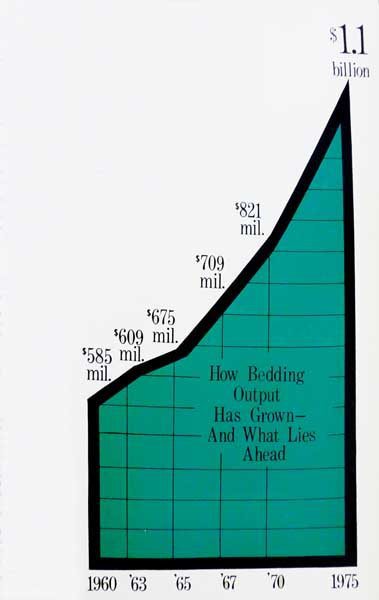
In the early to mid-1970s, the bedding industry was hampered by material shortages, inflationary pressures, the oil crisis and recession. Nevertheless, this was a prosperous period. In February 1967, Bedding magazine trumpeted that the bedding industry had ‘joined the $1 billion club,’ at least when it came to retail tallies. The U.S. Census Bureau, however, pegged the wholesale value of mattress and foundation shipments in 1967 at just over $708 million. But even government statisticians thought the $1 billion figure wasn’t far off, estimating that the ‘output of America’s bedding industry will top the $1 billion mark by 1975,’ according to an April 1970 Bedding article.
As this discussion indicates, measuring the size of the bedding industry is not without complications. The Census Bureau had long provided the industry’s statistics though, frankly, NABM often questioned their accuracy—even as the association worked with the government to update data-collection efforts to better reflect the industry’s actual manufacturing and sales practices. NABM began producing some of its own reports, but they were based on Census Bureau numbers. In the mid-1970s, NABM got the chance to create its very own statistics program when the Ford administration set out to reduce federal paperwork—the beginning of the end of the Census Bureau’s bedding reports.
By 1981, the Census Bureau was completely out of the mattress stats business, and NABM was conducting its own industry surveys monthly, with the help of a former Census Bureau statistician and an outside firm. Next came quarterly forecasts, an annual report and 24-month forecasts using an econometric forecasting model created by the University of Michigan. As the editors of Bedding wrote in March 1983: “A reliable picture of industry sales totals and trends is among the most valuable services a trade association provides.”
NABM becomes ISPA
Incorporating suppliers more fully into NABM was not the only membership change during this period. With the rise of licensing groups, the board voted in March 1967 to allow bedding group headquarters to become members—and for all their member plants to be included, as well. As A.S. Roistacher, then-NABM executive vice president, said, “This new provision gives recognition to the growing importance of merchandising groups in the American bedding industry. Under the old NABM bylaws, written 50 years ago, group headquarters were not considered part of the industry.” Later, NABM courted another kind of company, creating in 1985 a new factory-direct membership program with a modified dues structure to help bring those producer-retailers into the association.
The association was changing, and by the mid-1980s, NABM was ready for one of the biggest changes of all—a new identity. Leaders sought a name that would better reflect the mission and scope of the association, as well as its goals for the future, which included greater reach and involvement internationally, starting with producers in Canada.
In the fall of 1985, NABM asked members for help in brainstorming. Al Ruh of VWR Home Furnishings, a supplier member from Cerritos, California, and Don Vesey of Spring Air in Hayward, California, were credited with dreaming up the winner—International Sleep Products Association.
In making the announcement in the May 1986 issue of Bedding, Russ Abolt, then-association executive vice president, said, “The International Sleep Products Association accurately reflects our evolving position within the changing business environment. We feel this is a name to carry us into the 21st century.”
ISPA and its new logo debuted in March 1987 in the industry magazine, with the editors heralding the trade group’s new identity: “The National Association of Bedding Manufacturers is dead. Long live the International Sleep Products Association!” ✦
Association approves ethical code to govern conduct
On March 6, 1967, the National Association of Bedding Manufacturers adopted a “Code of Ethical Conduct” that had been in the works for several years. It read:
“Whereas man spends one-third of his life in bed, and whereas the Bedding Industry serves society in the betterment of health, happiness, and the fulfillment of life, we dedicate ourselves, as members of NABM, to accepting the obligations of this service.
“We pledge ourselves individually and collectively to abide by the following Code of Ethical Conduct:
“We will do our part to help educate the public to a better understanding of the importance and contribution of good, people-sized bedding to health, happiness, and the fulfillment of life. We will cooperate with our Industry in projects designed to achieve this objective.
“We will always conduct our business in such a manner that the fullest light of publicity can be turned favorably upon it.
“We will maintain truthfulness and accuracy in labeling and advertising our products.
“We will compete with other bedding manufacturers on an honorable and fair basis and will make no false statements or misrepresentations concerning them.
“We will cooperate in every reasonable and lawful manner with other members of our industry for the betterment of the Bedding Industry and its advancement to a still higher level of service.
“We will deal fairly and honestly with both our suppliers and our customers.
“We will respect and promote the interests of our employees and observe carefully all laws pertaining to their employment, health, welfare, and safety.
“We will observe all laws relative to the conduct of our business and will avoid practices which might cause the Industry adverse notoriety or bring it into disrepute.”
The association objectives
In 1982, the National Association of Bedding Manufacturers adopted five key objectives for itself:
1. “Public relations: To improve the environment in which the industry conducts its business.
2. “Government relations: To monitor and influence public policy-making processes which impact on the industry.
3. “Industry statistics: To collect, analyze, and disseminate comprehensive and accurate statistical data on the industry.
4. “Membership development: To aggressively seek and retain membership and membership participation from all qualified manufacturer, supplier, and association segments of the bedding industry.
5. “Communications: To provide a comprehensive forum for the exchange of ideas and issues involving the industry and NABM members.”
 Movin’ on over
Movin’ on over
Though firmly rooted in its birthplace of Chicago for much of its history, the National Association of Bedding Manufacturers bid its final farewell to the Windy City, turning what had been a second office opened in the heart of Washington, D.C., during the war years into the association’s official headquarters. In 1981, NABM was on the move again, though this time it didn’t go far. To escape escalating rents, the association crossed the Potomac River to Crystal City, Virginia. Then, in 1987, again because of rising rents, it relocated to the Old Town area of Alexandria, Virginia—this time becoming a property owner.
“There was no question that ISPA needed to remain in close proximity to the nation’s capital but we faced the prospect that rental costs would eventually make that prohibitive,” said Norman Veitzer, then-association president, in a May 1987 Bedding magazine article. “From a financial standpoint, purchasing our own property was the best way, perhaps the only way, to contain costs over a long period of time.”
Magazine changes with the times
As mattress constructions and manufacturing plants grew more sophisticated, so did the magazine that chronicled the changes. It was during this era that Bedding magazine, published monthly by the National Association of Bedding Manufacturers, began running full-color ads and adding glitzy treatments, including metallic inks and die-cut inserts, to its pages. In 1971, Bedding moved from letterset to offset printing, saving advertisers valuable time and money.
In 1969, the magazine’s headquarters moved to Washington, D.C., joining other NABM departments and functions already there. “To cope with the tremendous amount of industrial news now emanating from the seat of government, NABM’s Board of Trustees and the magazine staff feel the move will help build Bedding into an even more useful, working tool for upholstery and bedding production and marketing,” the editors explained in the August 1969 issue. In March 1983, the magazine resurrected a “Washington Affairs” column—not to report on war shortages and price controls, as had been the practice during World War II and the Korean War, but to keep readers up to date on critical legislative and regulatory activities. Editors worked with NABM’s then-new Government Affairs Committee to plan coverage.
But the biggest change came in March 1987, when Bedding magazine got a design makeover and a new name. “BedTimes has a contemporary ring, is upbeat,” the editors wrote. “As we move into the latter part of the Eighties with a renamed, redesigned, rededicated magazine, we hope that you’ll look to BedTimes as the industry publication that’s a must-read for you and your colleagues.”
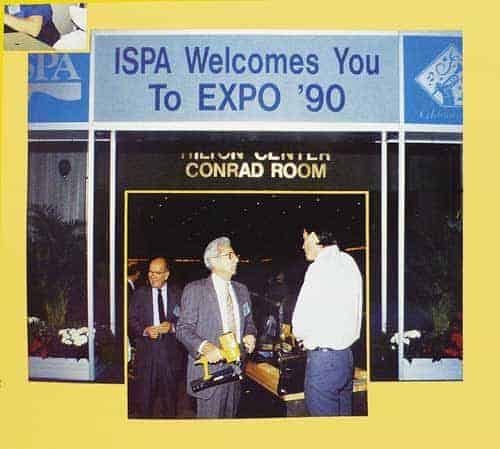
Since the early 1970s, the National Association of Bedding Manufacturers has hosted a convention and supply show one year and a convention alone the following year.
We gather together
From its very beginning, a major highlight of the industry’s trade association calendar was the annual convention—an event made even more important when an exhibition of components and machinery was added in 1920.
Year in and year out, the event was held in Chicago, with only a brief move to the warmer climes of Miami Beach in 1960. But in the early 1970s, the National Association of Bedding Manufacturers made two major changes that created the formula the association uses today when members of the industry gather together. First, NABM’s board voted to host the full convention and supply show one year and the convention alone the following year.
Second, NABM decided the alternating events would move around the country. During convention-only years, the industry would head to resort locations for educational programs and “special presentations on supplies.” It just so happened that the first convention-only event, in Las Vegas in 1972, was a particularly big draw as the industry was in the midst of dealing with new federal flammability regulations.
(With all this talk of events, now is a good time to note that the next ISPA EXPO will be March 9-12, 2016, in Orlando, Florida. Mark your calendars!)
Read all seven parts of this month’s special ISPA 1966-1990 centennial section:
Part I – Main feature: ‘The challenge of change’
Part II – New directions for mattress industry public relations
Part III – Uniform Monday Holiday Act brings sales, promotional opportunities
Part IV – The industry enters the computer age
Part V – The Sealy wars erupt: Sealy Inc., Ohio-Sealy duke it out
Part VI – Out with the old: Industry works to keep used mattresses out of circulation
Part VII – Product trends of the time: Waterbeds make waves
View this special section as it appears in the print magazine: BedTimes’ August digital edition.
Read previous chapters in the 100-year history of ISPA:
1915-1940: An industry comes together
1941-1965: A time of war, a time for peace





